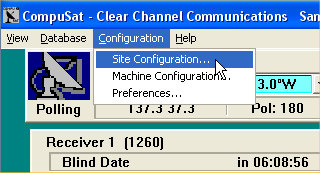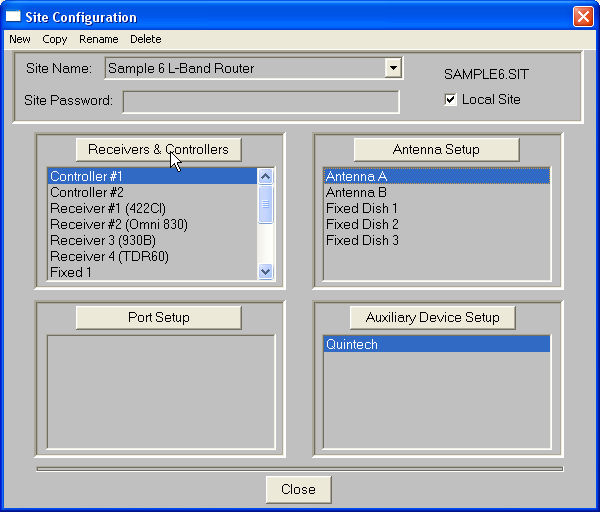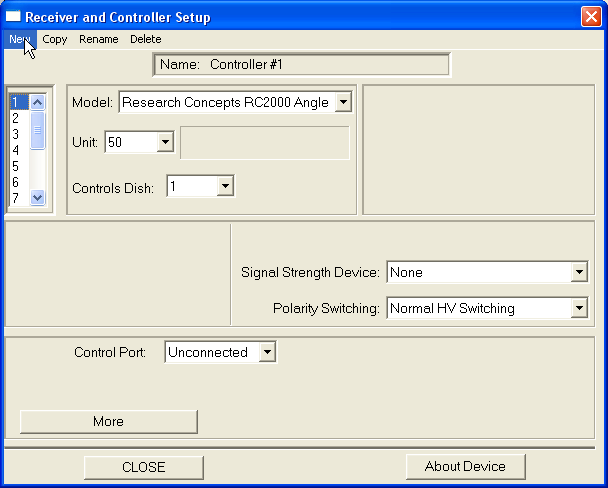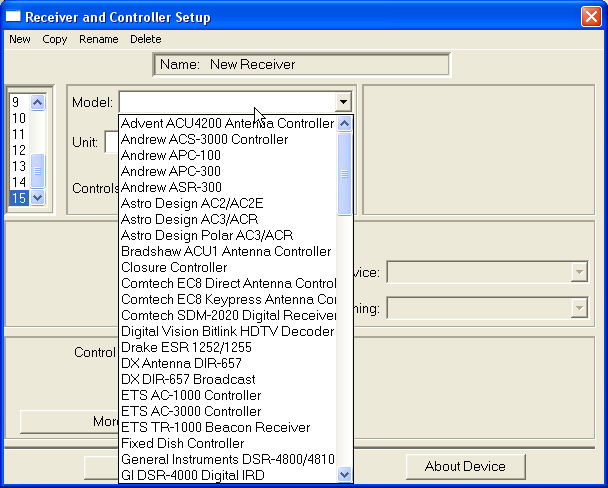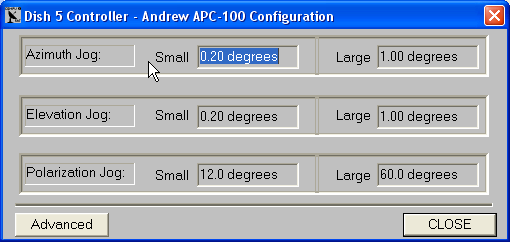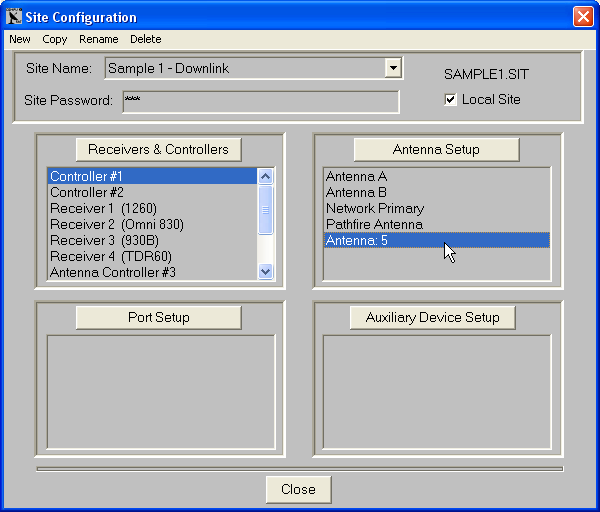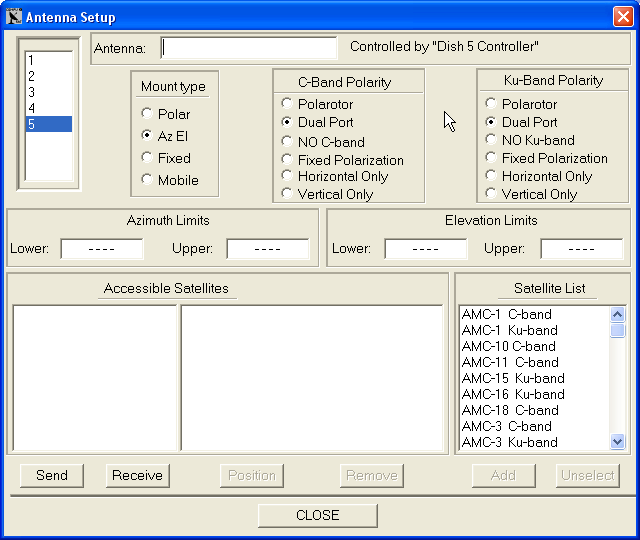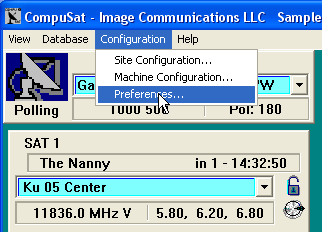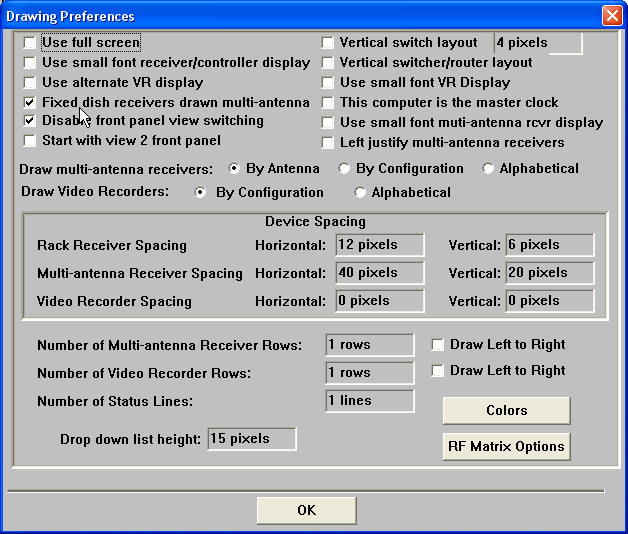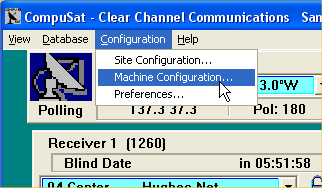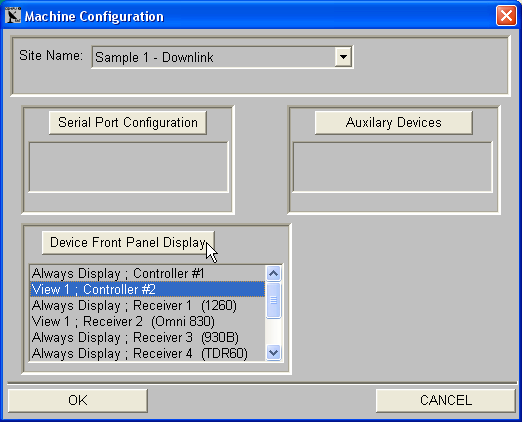Home :

COMPUSAT SUPPORT INFORMATION Adding Satellite Antennas
|

|
This page provides support for adding satellite antennas to your CompuSat system
You can add a new antenna to CompuSat by configuring the new antenna controller in your SIT data and then configuring the resulting antenna. Information You Need Before Adding the Antenna You will need the following information before getting started:
AddING the Antenna Controller to the site configuration To access site configuration, click the Configuration menu choice and select Site Configuration. NOTE: You must be logged in with administrator rights to access the site configuration dialog.
When you select Site Configuration, the following dialog is displayed:
Click on the Receivers & Controllers button to display the receivers and controllers editor.
NOTE: The column of numbers in the upper left is a quick index to all the devices defined in the receivers and controllers site data. You can edit/examine other devices quickly by highlighting one of the numbers. Clicking the New menu choice will instruct you to enter the name for the new device. This is the antenna controller's name, not the antenna name and will not show on the CompuSat Front Panel.
Enter the antenna controller's name and click OK.
Next, click the Model pick list and select the make and model of the antenna controller you are adding.
If the Unit pick list appears, set the value to match the address programmed into the controller's firmware. Please refer to the specific installation instructions for details on how to examine and/or change the address of the controller (here). Next, click the Controls Dish pick list and select the next available dish number. This is logical dish number of the new antenna in CompuSat. Next, click the Control Port pick list and select the serial port you will be using for this controller. Note: Leave the Polarity Switching pick list on Normal HV Switching. This is only used for specialized uplink systems
Most antenna controllers have additional configuration parameters defined in the More dialog. These configurations are specific to the controller's model. The configuration usually includes a screen for configuring the antenna's jogging parameters. An example is shown below. Please refer to the specific installation instructions for details on the More dialog for each receiver (here).
Enter the desired movement parameters for both large and small jog moves. NOTE: Changes to the More dialog do not take effect until a Reset Communications is performed on the receiver. Open the controller's jog screen from the front panel (click on Az/El display) to access Reset Communications. Click on Close to exit the More dialog. Click on Close again to close the Receivers and Controllers setup dialog. Now that we have added an antenna controller, a new antenna should be available in the Antenna Setup list in Site Configuration.
Highlight the new antenna (Antenna: 5) and click the Antenna Setup button, or double click the new antenna name.
Enter the antenna name:
Select the Mount Type for the new antenna.
Select the C-band polarity.
Select the Ku-band polarity.
Enter the azimuth and elevation travel limits:
If the Receive button is gray:
If the Receive button is available:
The drawing preferences dialog provides control over the antenna display process. Click Configuration/Preferences:
to display the Preferences dialog:
Click Drawing Preferences to display the Drawing Preferences Dialog:
Movable antennas The movable antennas are displayed across the top of the CompuSat display. The number of antenna's that can be viewed on one view depends on the display resolution of the monitor and a number of display setting parameters. The higher the screen resolution, the more antenna's that will fit across the top of your display. You may also adjust the following display parameters: The Use small font receiver/controller display changes the font used for the antenna controller and associated receiver display to use a smaller font, thus saving space allowing for more antennas across the top of the display. The Fixed dish receivers drawn multi-antenna saves horizontal space by electing not to show fixed antenna's as controllers at the top of the CompuSat display. This saves room to display the controllers you actually need to move. The receivers connected to the antenna will be drawn as if they were connected to multiple antenna's with the fixed antenna the only antenna they can choose. These receivers are drawn in an XY grid below the dedicated receivers and above any VR devices. We recommend checking this option unless you have a specific reason not to. The Rack Receiver Spacing fields control the spacing between columns of movable receivers and rows of receivers. When trying to make extra devices fit, set all the spacing to 0. Increase the amount for readability after you get the extra devices to display. Fixed antennas Normally, we do not display fixed antennas on the CompuSat Front Panel as they take up room and generally are not needed. CompuSat will always display a fixed antenna if the antenna has an uplink attached. You may also elect to display the fixed antenna just like the movable antenna's just for organization sake if you have the space. Normally, we will check the Fixed dish receivers drawn multi-antenna checkbox to remove the fixed antenna from appear across the top of the CompuSat Front Panel display. The Fixed dish receivers drawn multi-antenna saves horizontal space by electing not to show fixed antenna's as controllers at the top of the CompuSat display. This saves room to display the controllers you actually need to move. The receivers connected to the antenna will be drawn as if they were connected to multiple antenna's with the fixed antenna the only antenna they can choose. These receivers are drawn in an XY grid below the dedicated receivers and above any VR devices. The machine configuration dialog provides control over the antennas displayed in each view. Click Configuration/Machine Configuration:
to display the Machine Configuration dialog:
Highlight the antenna controller you want to adjust and click the Device Front Panel Display button or simply double-click the antenna controller you want to adjust.
The Configure Device Front Panel Display Options is displayed for the selected device. Click which views you want this antenna to be included with and then click Close. Note: If the antenna controller does not display in a view, none of the receivers dedicated to the antenna will display. No need to set the display options for these receivers.
|
Any questions? Call Image Communications, LLC @941-322-2534 |
| Contact Us | Copyright © 1991-2008 Image Communications, LLC | Image Communications, LLC |
